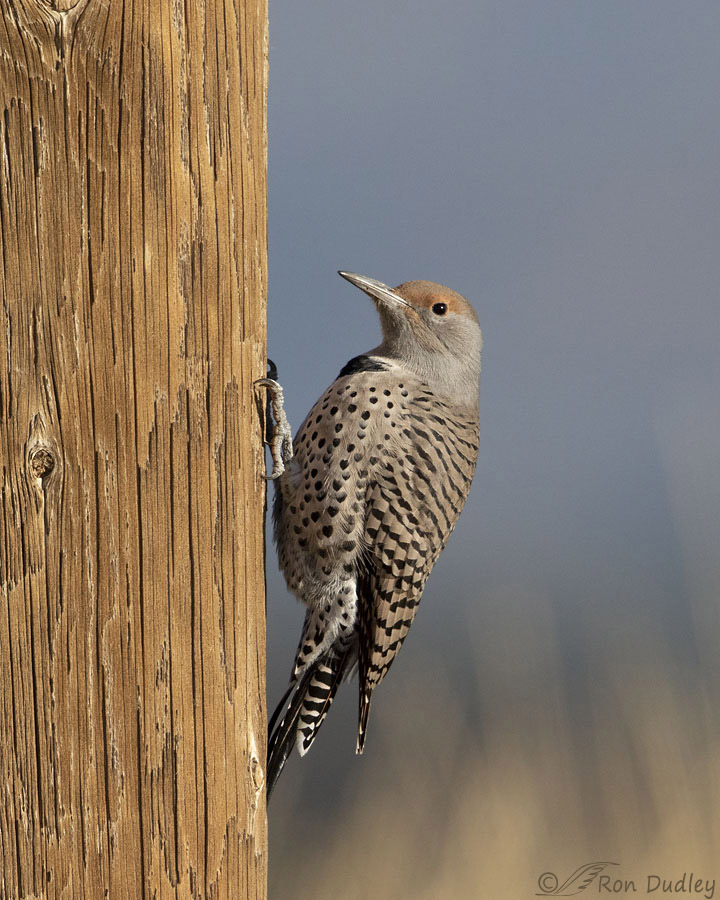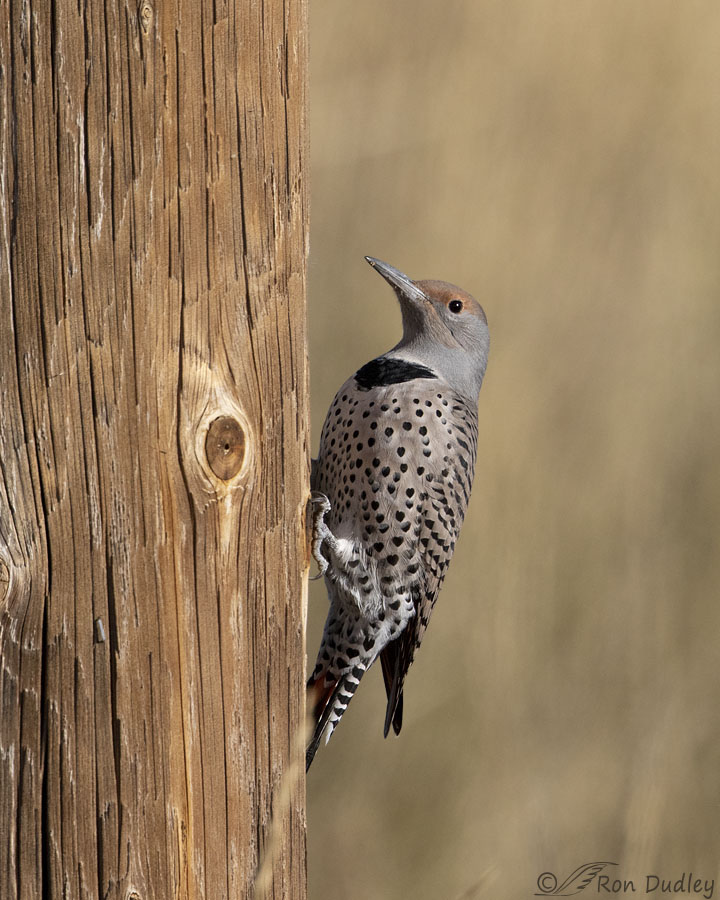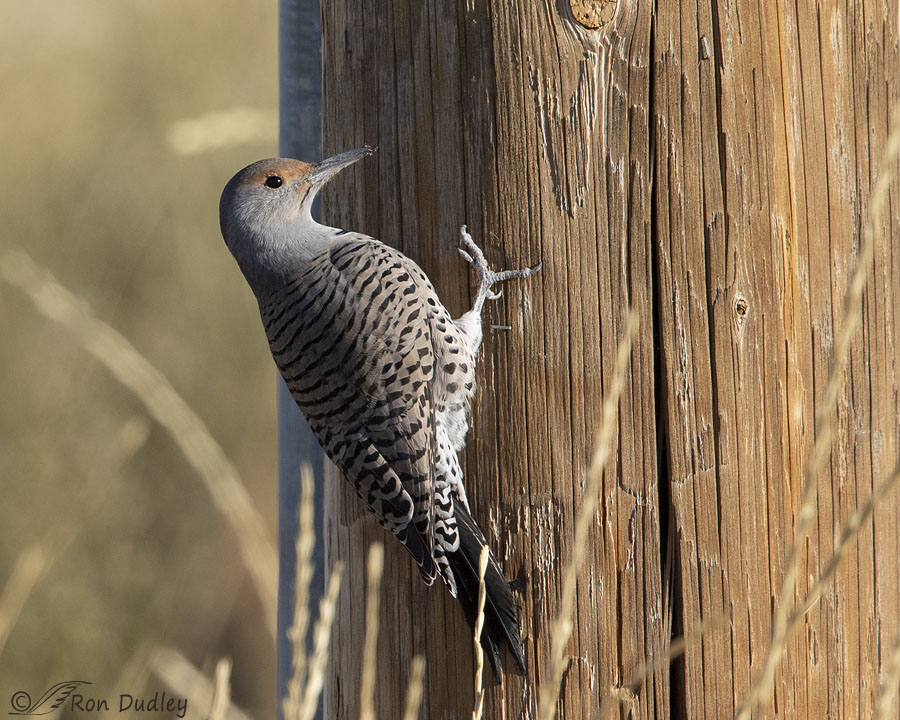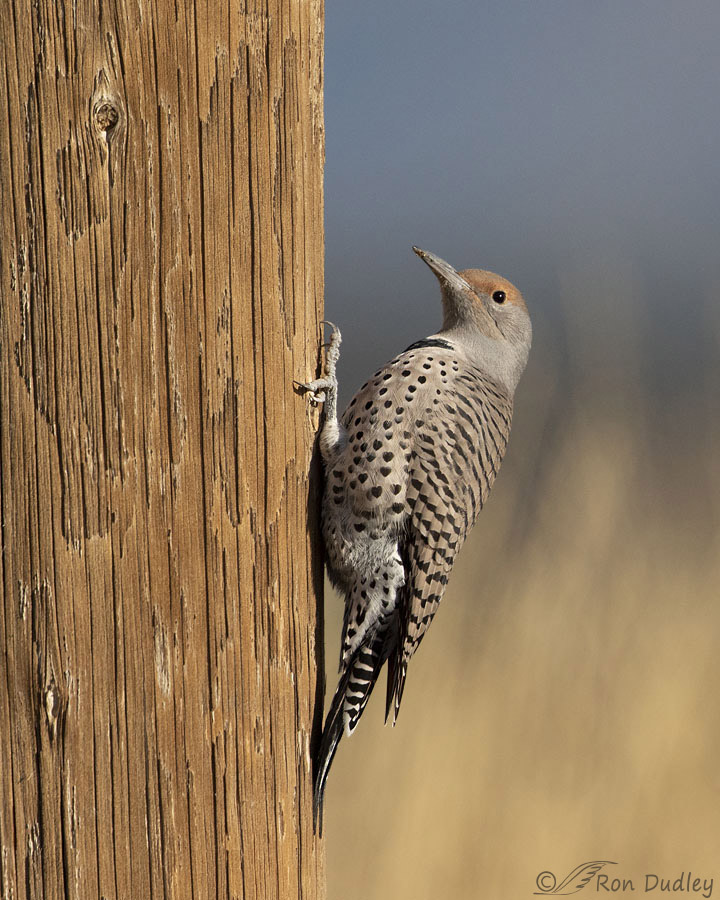It was a round trip journey so it must have consumed more energy than she obtained from the snack.

1/5000, f/6.3, ISO 800, Canon 7D Mark II, Canon EF 500mm f/4L IS II USM + EF 1.4 III Extender, not baited, set up or called in
Yesterday morning I spotted this female Northern Flicker landing near the top of a utility pole next to Glover Pond in Farmington. I’m not much of a fan of photographing birds on poles but flickers are among my most difficult subjects to approach and parts of the pole looked reasonably natural so when she allowed me to get fairly close I went for the gusto anyway. She was side-lit so she had to turn her head just right to get any light on her face but I still got several shots I like and I was able to document her largely futile attempt at finding food.
She started out near the top of the pole where I had blue sky background but as she descended straight down in her quest for insects in the cracks in the wood her face was shaded most of the time. This first shot I got that I like very much was taken when she was most of the way down so we’re beginning to see tall grasses in the background.

1/5000, f/6.3, ISO 800, Canon 7D Mark II, Canon EF 500mm f/4L IS II USM + EF 1.4 III Extender, not baited, set up or called in
Now she’s very close to the ground with nothing but grasses in the background. As far as I could tell she didn’t find any insects on her long journey down the pole but when she was nearly at ground level she…

1/2500, f/6.3, ISO 800, Canon 7D Mark II, Canon EF 500mm f/4L IS II USM + EF 1.4 III Extender, not baited, set up or called in
moved to the shady side of the pole and finally found a few ants which we see at the tip of her bill. From here she moved back to the sunny side of the pole and…

1/5000, f/6.3, ISO 800, Canon 7D Mark II, Canon EF 500mm f/4L IS II USM + EF 1.4 III Extender, not baited, set up or called in
climbed all the way back to the top. This turned out to be my favorite shot in the series.
The last time I saw her she was on one of the pole’s crossbeams but there were wires in front of her so I left her and drove to nearby Eccles Wildlife Education Center where we visited briefly with our old friend and Center director Billy Fenimore. And then we headed for home.
I don’t post birds on poles often. But I’ve mentioned before that flickers around here that aren’t “city birds” are very difficult to get close to and my luck with them has generally been dismal. So when this bird didn’t fly off as I approached I couldn’t resist aiming my lens her way.
Ron


Love how your pictures capture the use of the tail as support against the pole while climbing (or pausing.) Great shots-as always.
Thank you, Marcia.
Every time I see a Flicker I am captivated by their looks. The colors and patterns of their plumage is really special and their movements are so graceful, fluid and quick, without looking rushed.
Beautiful photos Ron, thanks for sharing.
Now its time for me to watch the Serengeti story.
You have keen powers of observation, Dave – especially this part: “so graceful, fluid and quick, without looking rushed”.
So per your suggestion from yesterday’s blog I watched “The Serengeti Rules” and then there is today’s Feathered Photography post. Out of curiosity I googled “birds as keystone species” and look what popped up from Birdnote: https://www.birdnote.org/show/woodpeckers-keystone-species.
Neat! I didn’t know that flickers were one of them but it makes sense.
Ron, I’m glad that she was so cooperative in terms of your photos. She is a pretty bird and probably still has an empty stomach.
Thank you for the post.
Thank you, Alice.
Dick’s story about how the hybrid zone came about is an interesting one but there is reason to doubt its validity. Many poles were treated with creosote or other substances to keep out insects so new poles provide only small opportunity for flickers to feed. While flickers will search trees or poles for insects, they prefer to feed on large ant colonies in the ground which provide an easier and more abundant source of food. Their tongue is longer than most woodpeckers and well-adapted for capture of these ants. (Downy Woodpeckers have short tongues for capture near the surface; Hairy Woodpeckers have longer tongues to reach deeper into the tree, but neither has a tongue as long as a flicker that reaches ground-dwelling ants.) The ends of a flicker’s tongue have short, rounded spines the hold a sticky saliva to capture the ants. Woodpeckers that normally drill into wood searching insects have sharper spines on the tongue that aid in prying the insect from its burrow. But, one of the biggest reasons for doubt are some of the several scientific studies on this hybrid zone. It’s been of great interest because of its great stability. Unlike most hybrid zones that are relatively new, it has not shown much change. That is, it has not gradually changed to favor one type. Hybrids are possible in nearly any plumage variation you can imagine. This zone of hybridization and its long-term stability have been present for at least 10,000 to 13,000 years according to some estimates. (Long before we were around to carry poles across the country.) There are many other similar species of flickers which would likely hybridize with Norther Flickers if the opportunity were possible. Hybrids with Gilded Flickers certainly occur in the southwest. This is a very interesting species.
Thanks very much for all that background, Dan.
Ron,
I don’t mind the pole at all!
Thanks,
Stephen
Steven, I think it looks pretty darned good for a utility pole.
I am v grateful that you squashed your dislike of birds on poles and gave us this series. Many thanks.
Good. Thanks, EC.
One of my favorites, Ron! I get the yellow-shafted in the yard nearly every day, but I never get tired of seeing them!
They’re easy to like, Diane.
Beautiful light. To me growing up in Centerville the call and sight of Northern Flickers meant fall was here. My parents have not noticed as many in recent years, I still see a lot in Salt Lake where I live. They do like the utility pole in my back yard, mostly as a perch.
I see quite a few of them in lots of places, April. One of the few species that based on my own observations doesn’t seem to be in decline. Well… House Sparrows and starlings too.
This is a wonderful picture of a female intergrade (“Red-shafted” x “Yellow-shafted”). The brown from the bill and over the eye along with the gray back of the neck and top of the head shows that characteristic.
Growing up I heard the story of when the train tracks and telephone poles were set across our country as the way the Red-shafted Flicker and the Yellow-shafted Flicker met and started to interbreed. It wasn’t until much later that science decided to separate them. Science needed time to see if in fact the mating was successful and whether the offspring could be successful. Man do we cause change!
Dick, I actually thought she might be an intergrade but I wasn’t sure. Yesterday I even mentioned that possibility to Mia and told her that I hoped you would comment because I thought you’d know. Thanks.
Nice! Glad she cooperated! The lighting, coloring of her/the pole/background all come together. They are fun to watch working a tree trunk or, in this case, pole – we have an old pole still standing that they work regularly in a spiral pattern rather than up/down. More likely to see them on an ant hill on the ground and they DO spook easily!
The lighting, coloring of her/the pole/background all come together. They are fun to watch working a tree trunk or, in this case, pole – we have an old pole still standing that they work regularly in a spiral pattern rather than up/down. More likely to see them on an ant hill on the ground and they DO spook easily! 
Judy, this one never spiraled at all that I noticed until she got to the bottom of the pole. She went almost straight down and then straight up.
This is a wonderful series, especially since I rarely see a northern flicker. Two weeks ago, I found a boat-tailed grackle atop a sign post eating the forward half of a crawfish. I knew they would catch and eat tiny bait fish like our glass minnows, but that crawfish was a surprise.
Shoreacres, I just checked BNA on the diet of Boat-tailed Grackles. Here’s what they say:
“Omnivore: arthropods, Crustacea, mollusks, frogs, turtles, lizards, grain, fruit, tubers, and food scavenged from humans and domestic animals.”
They list food items in approximate order of importance so since Crustacea are near the top of the list I suspect crayfish tend to be a significant portion of their diet.
How cool! Now, since I’m still in the very early stages of learning about all this, I’ll go ahead and ask — what’s BNA?
Cornell’s Birds of North America Online. It’s a very comprehensive pay site but it’s worth every penny to me.
Thanks! I use their Merlin app and go to the site, but the abbreviation wasn’t familiar.
Nice series Ron. One of my favorite birds here, and for some probably unexplainable reason they are not as elusive here. I have lots of good closeup Northern Flicker photos from various locations here around our lakes and forest areas. The funniest ones though were many years back when two or three of them literally were drunk in our back yard from gorging themselves on juniper berries.
Everett, inebriated birds is something I’ve heard a lot about but I don’t remember ever witnessing it.
I’ve seen robins and waxwings drunk on fermented berries, but the best one ever was my pet squirrel, who overindulged in fermented mesquite beans I’d forgotten in the closet. He was a mean drunk, too.
Mean drunks happen, apparently no matter the species…
I have seen robins and waxwings drunk on berries. It looks at first like a possible head trauma, inability to balance or fly well, but the usual give away is all the berry stuff on their beak and face. They recover in 12-24 hours and we let them go.
Great catch. Elusive and quick for sure! It’s always a good day when you can get such great photos of this bird. For a bird their size they can travel up, around, and down a tree as fast as a little brown creeper. Many times I see movement by the edge of the road and then I see the flash as they are gone. This time of year I’ll see them in small flocks but finding more does NOT make it easier to catch them.
“but finding more does NOT make it easier to catch them”
That’s for sure, Kathy. “A bird in the viewfinder is worth two (or more) in the bush”…